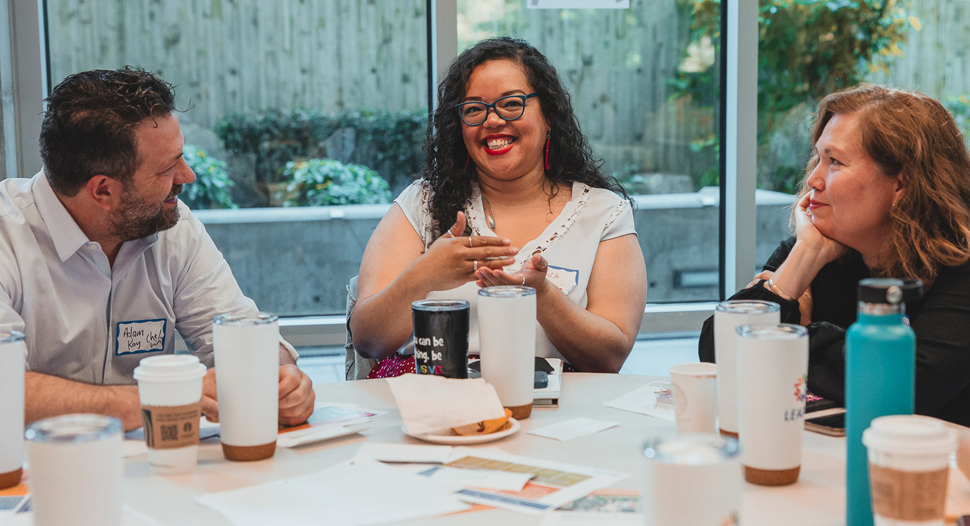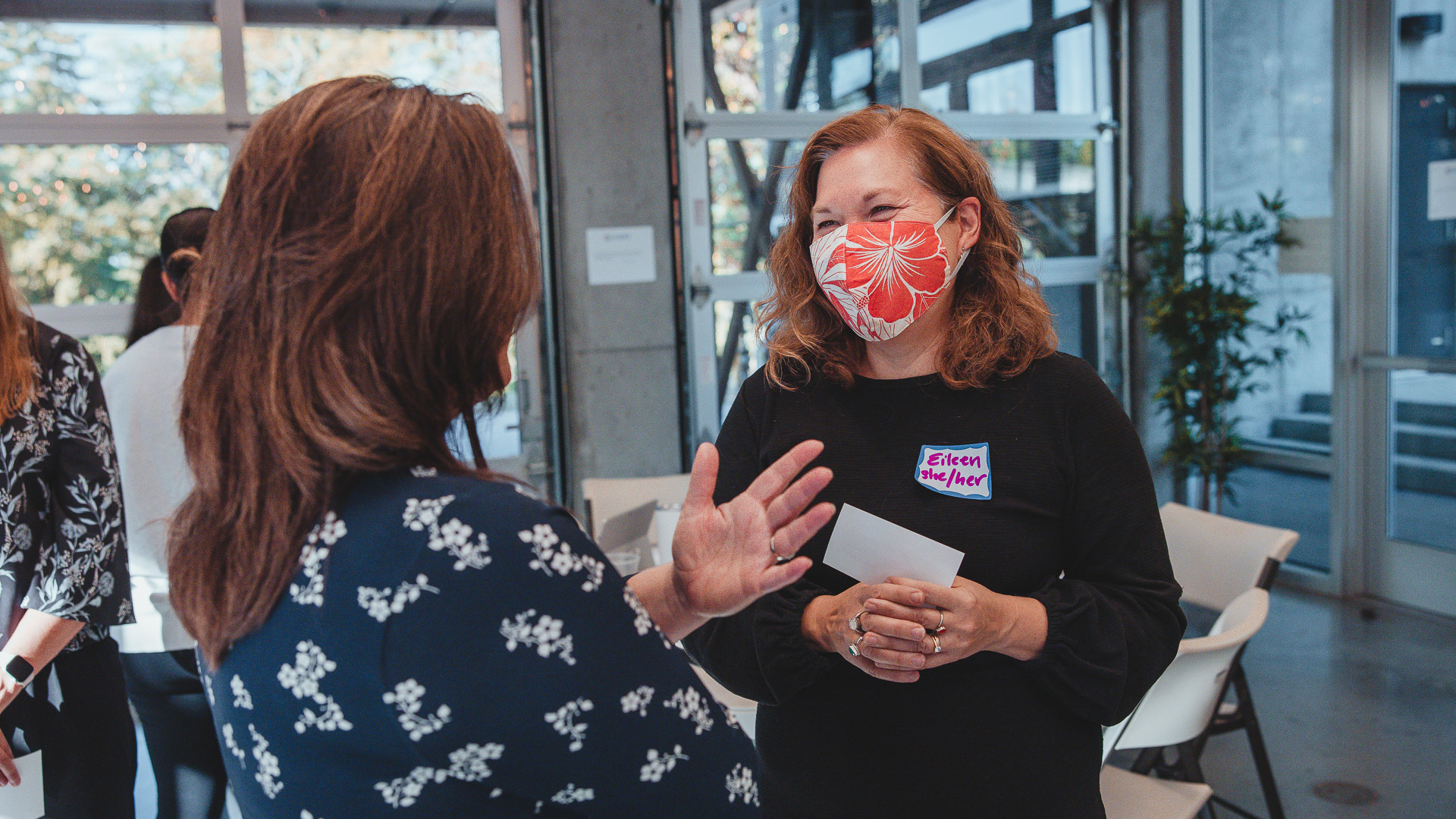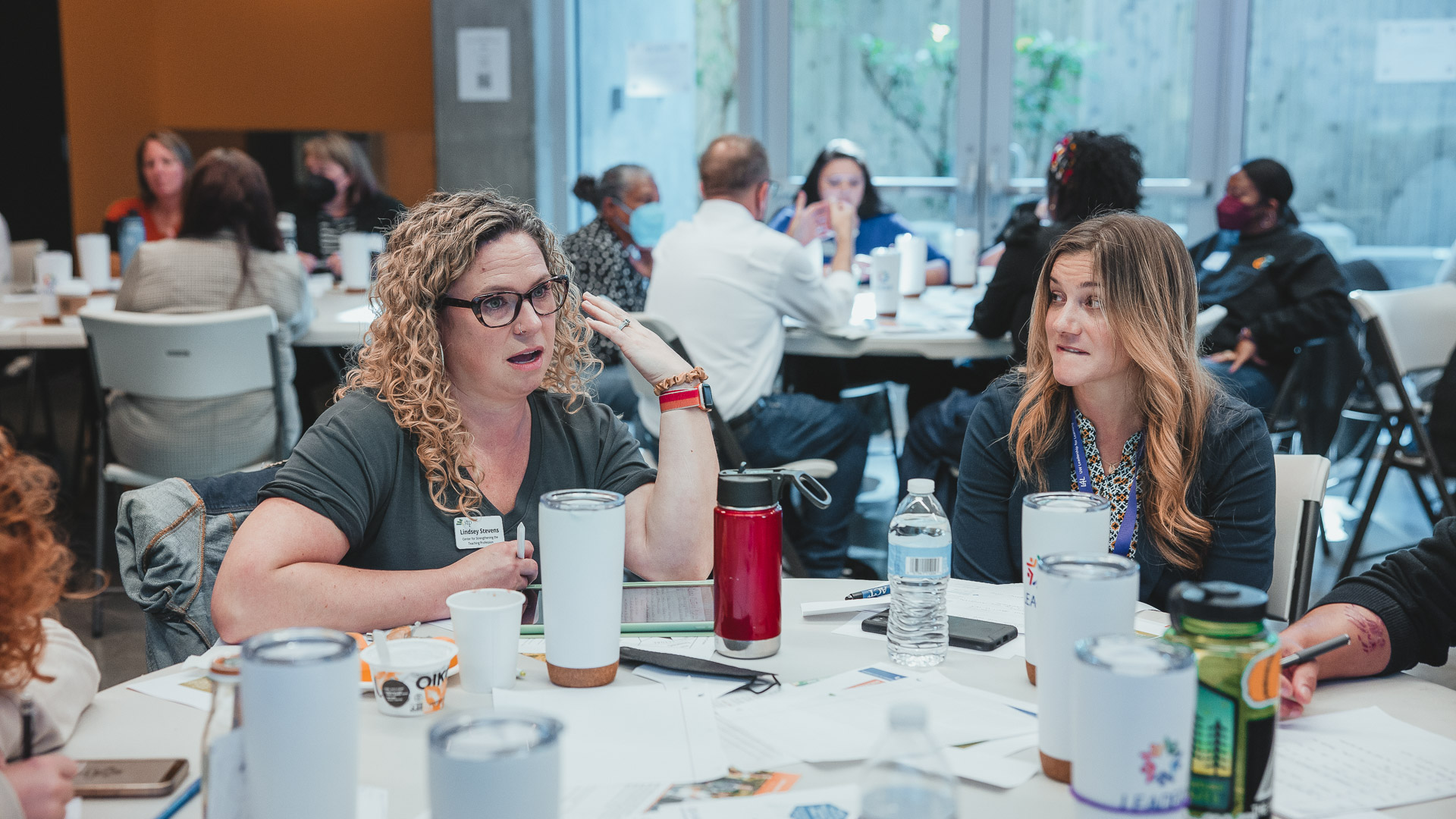
“This year, after two years of work, we got youth on the Seattle school board,” says Kaley Duong. She’s a Youth Wisdom Council intern at the Puget Sound Educational Service District (PSESD), talking about her efforts before joining the team. Just out of high school, Duong brings plenty of advocacy experience to her internship. “This work needs to happen in more school districts so youth can be on hiring panels and be part of the decision-making,” she says. “It’s our education.”
“Students will tell you this is a top priority to have educators who reflect our communities,” says Eileen Yoshina, director of Equity in Education Services at PSESD. For Yoshina and her team, who have spent the last five years growing a strategic program to retain educators of color, the LEADER Initiative funding couldn’t come at a better time.
Because it’s a top priority for students and communities and a driver of equity and thriving, Yoshina wants to see this kind of systemic equity work receive lots more funding. “We need more resources behind the labor involved in making transformative changes,” she says.
Where does this labor happen? In community. In this case, a Youth Wisdom Council, a Community Wisdom Council, and an Educators of Color Leadership Community (ECLC) provide leadership and insights necessary to illuminate pathways forward. On the youth front, Duong is currently working with the Youth Wisdom Council on community conversations, getting perspectives from students of color on their experiences with or without educators of color.
Related to teachers, Érica González Jones brings her background as an educator to her work with the ECLC in her new role as manager of Equity in Education at PSESD. “I went through the personal experiences of being in a school and realizing just how important the retention aspect was because I was not thriving,” says González Jones. “If I’m not thriving, how am I helping students and families of color to be thriving?”
A founding member of the ECLC, Tamasha Emedi-Frye describes what it was like as the ECLC took shape. “It was one of the coolest processes I’ve ever been a part of,” she says. Yoshina brought a collection of individuals together to focus on recruiting and retaining teachers of color, letting the group become what it needed to be. “It’s the only thing I’ve ever seen approved by the district that was only for people of color,” says Emedi-Frye. “We went in wild directions, and Eileen built the structure around us.”

Emedi-Frye credits the ECLC with helping her grow into her current position as assistant principal at Hazel Valley Elementary in the Highline School District. “Because of ECLC, I believed I could go back to school and get my admin certificate,” she says. The group also helped her make a move to another school.
Now, Emedi-Frye applies what she’s learned in her current school with race-based caucusing for educators of color and white allies, authentic peer coaching, and ensuring their Grow Your Own program, for paraeducators to become teachers, continues to keep a racial lens. “You might be recruiting educators of color, and they are all leaving, but your numbers look good because whites are retained,” she says. “You need a concrete idea of who is staying and why.”
Another critical piece for Emedi-Frye is to get more people to consider the teaching profession. “You can become an educator at any stage of life,” she says. “You don’t have to make that decision when you’re 18. And the people who hated school are the ones we want. They know how the system wasn’t working for them.”
“A large chunk of our funding is devoted to ensuring community members can participate,” says Yoshina. “We stipend their time, and we pay for substitute teachers. We prioritize and value that if we are going to diversify, educators of color must help us do that.”
“ECLC is what it is because of people participating in it,” says González Jones. “Retention is the best form of recruitment. If educators are thriving, then students and families are thriving. It’s cyclical and leads to more educators of color knowing I will be valued and seen. I will bring my brilliance and share it and diversify the educator workforce.”
“This work can’t wait, and it needs to be sustained,” says Emedi-Frye. “In the Pacific Northwest, we know all the right words like equitable, anti-racist, racially-just, historically-marginalized, queer-inclusive. But words alone do not retain human beings. What retains human beings is relationships, and that takes time and action. Otherwise, it’s unsustainable. You’re putting it on people to recruit and retain themselves and hoping they won’t get burned out.”
“Our voices are valuable,” says Jacquetta McGowen, a parent and community leader. She co-leads the Community Wisdom Council with Angelica Alvarez, PSESD’s Student, Family and Community Engagement manager and PSESD’s Transformational Collaborative alongside PSESD staff. “Some people are taking time off to do this work.”
“I am hopeful because we are beginning to see more grant opportunities that build in community-building, partnership development, and co-design in the shaping of the goals and the work that is funded,” says Adam Kay, director of Collaborative Improvement Networks for Racial Equity at PSESD.
In addition to money, sometimes people want to be compensated in other ways, Alvarez points out. She has been exploring giving course credits to youth in the Youth Wisdom Council. It’s also critical to ensure the process goes beyond checking boxes.
“Sometimes it can feel overwhelming,” says Emedi-Frye. “But the truth is, you can just start changing and pushing and trying things. Take low pay for paraeducators. I don’t know how to fix that, but I can talk to HR, lobby the state, and change evaluations. I can give my teachers more time to collaborate by changing how I run staff meetings and having meetings one day a week instead of two.”
The more leaders involved in this work, the better. “We’re in the process of recruiting new members across several counties,” says Alvarez. “The goal is to bring new voices, people who are already leaders in the community but not uplifted, really diverse voices from diverse backgrounds.”
“People are doing great work all over the state and this is an opportunity for all of us to come together around that,” says Erin Stewart, special services director at PSESD.


Given the collective wisdom involved, the potential for this work becomes limitless. Sui-Lan Hoʻokano, the director of Cultural Programs for the Enumclaw School District who participated in the initial creation and now facilitates with ECLC, sees the work within a larger context.
“The environment is one of the most under-utilized educators,” says Hoʻokano. “When we connect to more than just ourselves, we awaken senses that allow us to find our purpose and place within the ecosystem. Understanding our relationships within our environments personally, professionally, outside and in our schools, we begin to shift into a collective responsibility. Instead of teacher/learner, we co-teach with the environment.”
In her work centering and amplifying leadership in the ECLC, and with the Muckleshoot Tribe to support BIPOC students, she uplifts the importance of culturally responsible education through authentic community and student assets.
She gives the example of William Bill Jr., a Muckleshoot Tribal member who co facilitates with Hoʻokano on multiple projects and professional learning opportunity for educators around the state. This includes the Since Time Immemorial Training, CLIMETIME, and Master Based Learning that all recognize the value in traditional ecological knowledge.
Hoʻokano explains that these important relationships ensure equity for all students when embedded in the culture, structure, and pedagogy of schools and education systems. Students’ individual paths, lived experiences and assets become an active part of the learning process. “It brings an awareness that education does not exist in a vacuum, and that not all knowledge is learned in one school,” she says.
“There’s a lot of talk about social-emotional learning (SEL),” Hoʻokano says. “I would rather call it wellness because you can’t teach a broken spirit, and a broken spirit can’t teach. We need to know what wellness is for our educators, in our classrooms and students.”
She equates this wellness to the traditional stewardship of the ecosystem of her homeland of Hawaiʻi. The water comes down from the mauna (mountain) top, getting filtered along the way and giving life to the entire community. Everyone who lives within the ecosystem plays a role in maintaining wellness. “To contribute to our collective wellbeing, we have to understand our identities, place, and purpose and be responsible to the needs of the entire community, “ she says.
Although it’s still early in this work, the benefits are already manifesting in immediate relief and promise for future generations. “In ECLC, we call it moving from survival to thrival,” says González Jones. “That is where the reward is. It’s hard work, heart work, and brilliant legacy work.”
“This work is restoring some of the exhaustion,” says Hoʻokano. “People are moving into leadership roles, becoming change agents. Teachers are shifting into principal positions or administrators in the Office of Superintendent of Public Instruction (OSPI). People are becoming Career and Technical Education (CTE) directors and going into congressional seats.” These changes, in turn, impact students. “Students see themselves in positions they’ve never seen themselves in before,” she says. She describes a Native student from a fishing family who graduated and became the youngest hire in an environmental agency working in hatcheries and fisheries.
Kaley also watches and learns as she looks to the future. After her PSESD internship, she plans to go to college, attend a school of social work and see where it takes her. “I’m passionate about school, but I don’t think being a teacher would suit me,” she says. “There are other ways to be involved in education, though, from working in an agency for the school district to community organizing. I still have this huge passion for encouraging others to become teachers. Teachers are getting pushed out, and students aren’t getting the teachers or curriculum we deserve.”
Alvarez describes the web of support in the making for students and teachers, remembering an instance during their online community conversations with youth. The next generation inspired her with the questions they asked about what it looks like and feels like to be a successful educator of color. Even more, she remembers a moment when the screen froze for one student, and another seamlessly picked up and continued. “As a person of color, if we miss a beat, we live in fear of losing our jobs or being reprimanded,” she says. “But when we work in partnership and within these relationships, we have the room we need to grow knowing that someone is there who has your back, ready to pick you up and move forward.”
Find out how you can Get Involved, explore our virtual Events, or sign up below for news updates about the LEADER initiative.
Get the latest — subscribe to our electronic newsletter.
By signing up you agree to receive occasional communications from College Spark Washington. You can unsubscribe at any time. We respect your right to privacy. Please review our Privacy Policy
